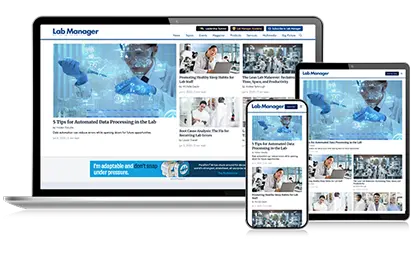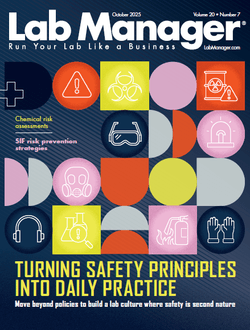
The past 20 years have seen an explosion in laboratory construction as academic, pharmaceutical, biotech, and high-tech companies have increased the level of research and development in their respective fields. The design of these laboratories has evolved dramatically as architects and engineers have responded to the growing requirements of the research community. Here are five trends in laboratory planning and design that will impact every research facility.
Increased support equipment
The increase in laboratory support equipment has created a demand for increased space in labs. More analytical equipment—mass spectrometers, highperformance liquid chromatographs, X-ray refractometers— has become readily available and even commonplace in research. Bench space is at a premium as these pieces of equipment occupy a greater percentage of the lab area. Most labs were never planned for this quantity of equipment and, unfortunately, many newly constructed labs aren’t either.

The King Faisal Specialist Hospital and Research Center is an 894-bed multi-facility, multi-entity tertiary care hospital and one of the leading healthcare institutions in the Kingdom of Saudi Arabia. Image Credit: Cannon Design
The growth of analytical instrumentation has added to the data storage and computational needs of labs as well. Personal computers and the network servers required to connect them create additional space demands at the benchtop and require dedicated server rooms. Building data cabling is constantly under pressure to provide the fastest and broadest network systems with high-speed connections all the way to the benchtop.
Advances in robotics will increase lab productivity and efficiency but will place further strain on available workspace. Already, robotic samplers and pipetting equipment are in fairly common use; new applications of robotic technology will cause lab planners to be yet more adept at spatial organization.
Support cores such as an imaging core, an omics core, or a characterization core are one design strategy that can begin to alleviate the space crunch. A support core is a centralized space containing equipment that may be shared by two or more research groups. Typical equipment in support cores are electron microscopes, mass spectrometers, or genetic sampling analyzers. Within a single lab, these types of instruments are not typically utilized at their full capacity— but when shared by multiple groups, they operate at a higher level of use. The support core also reduces space problems within individual labs and increases the utilization of these expensive instruments.
Cores also can be established with a dedicated technician who provides technical and operational expertise of the instruments. This expertise is critical since instruments are constantly evolving both in software analytical tools and detection hardware. To increase the utilization of the instruments, the technician can provide instrument analysis as an in-house service and as a for-fee service to out-of-house users. Technicians also provide training on and maintenance of the instruments.
Space flexibility
Laboratories are not static. Over time, the research being conducted will change as will the research necessity. In most cases, gutting a lab and starting from scratch is not financially feasible. Flexibility in the original planning and design is a key strategy for accommodating change and growth.
At the most basic level, dimensional modularity allows labs to be reconfigured in the most costeffective manner.
Flexibility also extends to mechanical systems. With the initial cost, lab mechanical systems can comprise up to 50 percent of the total construction cost, and later modifications to the mechanical system can be extremely expensive and disruptive. Flexibility in mechanical systems can be achieved by providing shafts, vertical space, and mechanical rooms that can be expanded in the future. The designer must right-size the building aspects that cannot be changed— floor-to-floor height, the structural grid, floor loads—in such a way that mechanical systems can be adapted to new requirements.
Building codes and safety guidelines
Building codes and guidelines, of course, provide for the safety of occupants. In the comparatively risky environment of the laboratory, more stringent codes are applied. And yet many of the provisions of laboratory building codes have been in place for decades and may not reflect modern safety advances. The lab designer should ask whether alternative safety methods might meet the intent of the codes; to do so will require close consultation with local authorities that have jurisdiction.
Energy/Sustainability
Energy efficiency and conservation, as in every building type, has become an important consideration in laboratory buildings. Laboratories are very dense energy consumers. To a greater degree than in most buildings, most of a laboratory’s energy is consumed by mechanical and electrical systems.
To provide a safe working environment, laboratories have used the concept of high air-change rates to flush out any dangerous chemicals. This large volume of air is exhausted and not recirculated as is typical in non-laboratory environments. Designers work with the codes, safety officials, and owners to look for ways to reduce this cost without forfeiting the safety of the space.
With the development of sensors that sample the room air for chemicals, the room air-change rates can be reduced. When chemicals are detected, the building exhaust system is increased for the area where the chemical has been detected in order to flush the area.
Another sustainable idea is the separation of the ventilation air system from the heating/cooling requirements. Currently buildings use a combined approach, where the ventilation system provides air changes as well as heating/ cooling. In laboratories where the required air-change rate is larger than needed just for safe ventilation, a lot of air is used to satisfy cooling loads. With the use of a separate device to supply water heating/cooling, such as a chilled beam, the air volume can be designed to satisfy the ventilation and makeup requirements and the chilled beam can be sized to provide the heating/cooling requirements.
Innovative and translational research
Over the past decade, translational research has become the most significant trend in laboratory operation. Simply put, translational research is the rapid application of promising discoveries from the basic to applied research to products. In the case of clinical research, from the bench to patient treatment, innovative research is facilitated by the physical colocation of multidisciplinary teams, incubator partnerships, and industry.
A prime example of this concept is a project in Buffalo, NY, where Kaleida Health, the Jacobs Neurological Institute, the Clinical Translational Research Center, and the Bioscience Incubator of the University at Buffalo came together in a single building to create the Global Heart and Vascular Institute. In this single building, innovative research and ideas can be seamlessly discussed, exchanged, refined, and tested. With the inclusion of the incubator facilities, ideas don’t get lost in academia, they get pushed out into the marketplace.

The Henry Bellmon Research Center is Oklahoma State University- Stillwater’s only building dedicated exclusively to research. Designed with modern features, this state-of-the-art facility brings together researchers from different departments who collaborate on projects at the cutting edge of modern research. Image Credit: Cannon Design
Conclusion
Laboratories have evolved far beyond the dark, isolated spaces of the past. New types of research, new approaches to research and new interdisciplinary interactions have all combined to push the design of labs into new territory. Increased support equipment and instrumentation, space designed with flexibility, modern safety advances meeting building codes, increased demands for sustainability, and the innovative research model have all impacted and will continue to shape how researchers work in their laboratories. Planners, designers, and owners who successfully respond to these directives will create institutions of leadership with the next generation of research discoveries.
The past 20 years have seen an explosion in laboratory construction as academic, pharmaceutical, biotech, and high-tech companies have increased the level of research and development in their respective fields. The design of these laboratories has evolved dramatically as architects and engineers have responded to the growing requirements of the research community. Here are five trends in laboratory planning and design that will impact every research facility.
Increased support equipment
The increase in laboratory support equipment has created a demand for increased space in labs. More analytical equipment—mass spectrometers, highperformance liquid chromatographs, X-ray refractometers— has become readily available and even commonplace in research. Bench space is at a premium as these pieces of equipment occupy a greater percentage of the lab area. Most labs were never planned for this quantity of equipment and, unfortunately, many newly constructed labs aren’t either.
The King Faisal Specialist Hospital and Research Center is an 894-bed multi-facility, multi-entity tertiary care hospital and one of the leading healthcare institutions in the Kingdom of Saudi Arabia. Image Credit: Cannon Design
The growth of analytical instrumentation has added to the data storage and computational needs of labs as well. Personal computers and the network servers required to connect them create additional space demands at the benchtop and require dedicated server rooms. Building data cabling is constantly under pressure to provide the fastest and broadest network systems with high-speed connections all the way to the benchtop.
To continue reading this article, sign up for FREE to

Membership is FREE and provides you with instant access to eNewsletters, digital publications, article archives, and more.













